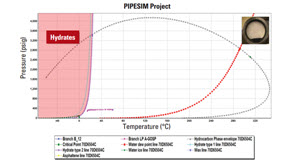Designing wells and pipelines to ensure produced fluids will be safely and economically transported to downstream processing facilities is a major challenge for engineers. The foundation for accurate modeling of these systems relies on three core areas of science:
- Multiphase flow
- Heat transfer
- Fluid behavior
The Pipesim simulator offers the most advanced steady-state modeling capabilities in the industry to address these critical aspects.
Multiphase flow modeling
The Pipesim simulator incorporates a wide variety of industry-standard multiphase flow correlations, as well as advanced 3-phase mechanistic models, including Olgas, Kongsberg LedaFlow Point Model, and the TUFFP unified model. These allow calculation of flow regimes, liquid holdup, slug characteristics, and pressure loss for all nodes along production paths of all deviations—vital information for designing and operating production gathering and distribution systems. The Pipesim simulator produces detailed flow regime maps at points of interest.
The design of pipelines and processing facilities can be optimized by predicting hydrodynamic slugs, including size and frequency, as a function of length traversed. Additionally, the Pipesim simulator predicts the risk of severe slugging in risers.
The Pipesim simulator includes a calibration feature for flow correlation, which can automatically adjust the holdup factor, friction factor, and U-value multiplier to match measured pressures and temperatures. Additionally, the comparison operation can quickly sensitize to flow correlations and help selecting the most appropriate model. High-resolution flow regime maps can also be produced for any point in the system. The Pipesim simulator includes code templates that can assist in compiling a user-generated 2- or 3-phase flow correlation via a plug-in DLL.
Heat transfer
Accurate prediction of heat transfer is critical for calculating temperature-dependent fluid properties, prediction of solids formation and the overall thermal design of your system. The Pipesim simulator performs comprehensive energy balance calculations that account for a variety of heat transfer mechanisms, including the following:
- Convection (free and forced)
- Conduction
- Elevation
- Joule-Thompson cooling and heating
- Frictional heating
Heat transfer models supported by the Pipesim simulator include a flow regime dependent model for inside film coefficient, plus an analytical model for convection in buried and partially buried pipes—shown to closely match more complex finite-element methods. The Pipesim simulator can also model internal natural convection using a proprietary methodology shared with Olga.
Fluid property modeling
An accurate description of fluid behavior is critical to correctly model the production system. The Pipesim simulator offers the choice between industry-standard black-oil correlations or a range of equation-of-state compositional models. Steam can also be modeled as a single component system using the ASTM97 Steam Tables. Depending on the type of application, users may select from an extensive set of features to model a wide variety of fluid types.
A number of SLB and third-party applications are capable of generating PVT files that can be used by the Pipesim simulator to interpolate fluid and transport properties. These applications include:
- Multiflash (InfoChem)
- PVTSim (Calsep)
- HYSYS (Aspentech)
- UniSim (Honeywell)
- ScaleChem (OLI Systems)
- dbrSOLIDS fluid analysis software (SLB)
- GUTS (MSI)
- AsphWax

